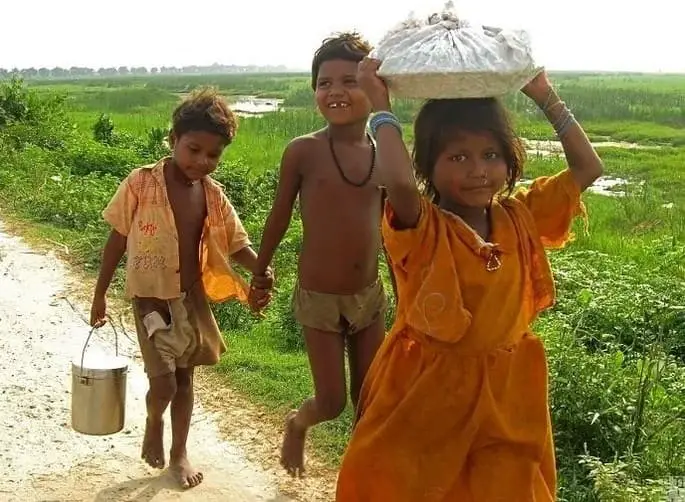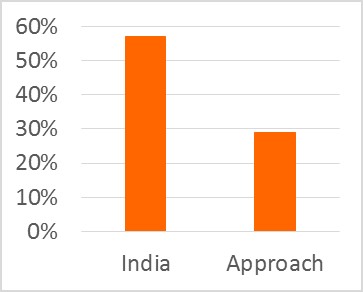Background and Introduction
India has legacy of high incidence of poverty and thus considered important aspect of development. The discussion on them had a back history right after independence starting from first organized committee in 1977 by YK Alagh, which set the mark of poverty line at INR 49.9/- as per the market prices of 1973-1974 (You, 2018). This was followed far after until next measures were adopted. Apart from poverty line mark, government also initiated number of schemes for poverty alleviation for rural poor sector. These Programmes can be categorized under –
- Wage Employment
- Self Employment
- Food Security
- Social Security
- Urban Poverty Alleviation
- Skill India development (BYJU’S, 2020)
Few Programmes to mention can be Pradhan Mantri Gramin Awas Yojana, MNREGA, Jawahar Rozgaar Yojana and many more. Thus, concern of rural poor has always remained a priority and to identify them is a continuous task. As per survey Data, India is now having only 21.9% population below the poverty line as per Govt of India but the measuring factors varies from state to state (Kumar, et al., 2014).

Figure 1 : Rural Poverty in India (Source: Geography and You)
The ‘identification of BPL’ (Below Poverty Line) has remained the most central and targeting methodology in Indian Context. The Study conducted by National Council of Applied Economic Research (NCAER) in six states, in 2007-08 concluded that 40% of BPL cards have been issued to people who are above the poverty mark (F, et al., 2009). The purpose of this mismatch can be perks of having a BPL Card. Having a BPL card entitles poor to obtain food grain, cooking gas, free housing, healthcare services, education etc. These benefits account for a large part of national and state government expenditures and thus their proper utilization should be done to those who deserves and that has always been a debated issue. The purpose of this article is to present the various approaches and methodologies adopted till now for identification and classification of poor and to talk about the criteria’s, justification and effectiveness for the same. So to begin, the first task is to find out, “Who is Poor” and how to identify them.
Related Articles:
- Definition and Identification of rural poverty in India
- BPL Identification in India – Expert Group (Saxena Committee 2009)
- Human Poverty Index (HPI)
- The need of revisiting “Food, Clothing and Shelter” as basic necessities for survival
Identification of BPLs in India
In India, series of exercises have been done in past targeting this question, in order to identify the Households lying below the poverty line to provide them with help. The first attempt was made during the Eighth five year plan in 1992, followed by revision in 1997 and again in 2002 and further a fourth method was published and corresponding Socio Economic Caste Census (SECC) was implemented (2011) (Sabina & Suman, 2012). Time to time alternatives and changes in approach/ criteria selection/ indicators are made and rigorously debated as each approach had its own critiques, details of which are presented in table below and individual indices and indicator level details can be looked upon the sources mentioned.
Table 1 Identification and Classification of BPLs in India
| Year | Key Idea | Approach | Limitation | Criteria |
| 1992 | Self-Reported Income | HH was identified as BPL if HH income < 11000 per annum | -Under reporting, – initially data was impossible to verify (worked under unorganized sector)
-Total HH income used rather than per capita. |
Income |
| 1997 | Consumption Expenditure | Done under two stages. First Stage identifies visibly poor HHs based upon 5 criteria’s:
Further in second stage information regarding consumption pattern were collected for past 30 days except those which were identified as visibly poor |
-Exclusion Criteria were too stringent,
-Poverty line not available for all states, -criteria for exclusion were considered constant in all states Non poor HHs identified based upon resource, rather than the capability approach of HHs. |
-Income
-Consumption -Socio-Economic Parameters |
| 2002 | Focus shifted towards socio economic indicators of well-being and used a multidimensional view of poverty | It contained 13 questions/ dimensions covering food, housing. Work etc. Depending upon the response it was rated from 0-4. Aggregated score of all if crossed the minimum limit (20 points – varied between regions) its APL else BPL. | -Methodological Drawback in identification (equal weightage to all was given –a point less in one could be compensated with an addition in other)
-Data quality & corruption (poor supervision) -Data content (conducted 5 years, question structure neglected resources turning to capabilities )
|
Socio Economic Parameters |
| 2009 Saxena Committee Expert Group |
Based upon exclusion principle | Worked under 3 stages a) exclude who are above poverty line based upon certain set of parameters, b) include the poorest who might be left out c) grade the remaining based upon a score structure and identify the poorest [to know the set of indicators refer Saxena committee Expert Group Report] |
Scoring Criteria had various alternatives and suggested | Socio Economic Parameters |
| 2011 [Socio Economic Caste Census] | Followed the Same indicators and approach as the Saxena Committee except the scoring | Scoring was a seven item binary scoring, which was much simplified. | Both the two methods gave different results. Error factor was high so which is more correct was argued. | Socio Economic Parameters. |
Source: Compiled by the author from various sources
Justification and Effectiveness
After going through various approaches, there might be confusion which is best or whether methodologies and approaches suggested really matter. Had different approaches given same set of Households, then question would had been which to choose, but on detail analysis done by various researchers and other studies (Sabina & Suman, 2012), it was found that there was a substantial difference between them. Where a national average suggests that BPL HHs ranges between 55-59%, it was identified that based upon above methodologies only 41% were identified as poor and 27% non-poor, thereby marking a significant difference of 32%, as represented in graph beside (F, et al., 2009). Thus, it suggests that methodologies somehow provide a lower count or excludes poor which must be included as these are dependent upon inclusion and exclusion principles (Moyna, 2015).

Further, through various studies it was observed that there are multiple deprivations which affect the poor and these are multidimensional in nature i.e., much more than just income and consumption pattern. Thus, Alkire and Santos in collaboration with UNDP developed an International Multidimensional Poverty Index (MPI), also included in human development report. The MPI is based on three dimensions and ten indicators and leads to attract towards itself through its simplicity and applicability (Sabina & Suman, 2012).
Related Articles:
- Planning and Informality in India
- Informal Sector in India
- Informal and Formal Settlements (Indian Context)
- Interpreting the “Sites of Entitlement” in informal India
Table 2 Dimension, Indicators, Deprivation Cut-offs and Headcount Ratios
| Dimension | Indicator | HH Deprived in Indicator if | % Deprived |
| Education | Years of Schooling | No HH member completed five years of schooling | 23.9 |
| Child School Attendance | Any school aged child in the HH is not attending school up to class 8th | 20.1 |
Similarly 3 dimensions (Education -2, Health-3 and Standard of Living-5) are identified with total 10 indicators along with deprivation cut-off and in fourth column % of Rural HHs taken. Equal weightage is given to all dimensions but it divides into one sixth in case of education and health, and one eighteenth in case of standard of living. It identifies HHs as MPI poor if deprived in 33% or more of the weighted indicators.
So, along with Saxena committee and SECC approach of inclusion and exclusion, this MPI has proved more useful as it keeps a check on the exclusion HHs, which based upon deprived conditions are excluded by SECC, thereby resulting under reporting (Sabina & Suman, 2012). In fact, we find that 57.1% of the households that would be automatically excluded by the SECC criteria (equivalent to 14% of all rural households) would be deprived in 20% of weighted indicators, which would be considered vulnerable according to UNDP’s definition and should be considered.
The occupation dimension has not been considered in MPI , thus to avoid inaccuracies the Mythology to be combined only with first 6 exclusion principles mentioned in the Saxena committee report. Apart from these mentioned, other factors that should also take into account includes:
- Inequality Factor Across the Poor
- Inflation Rate
- Education and Health
- Migration (Kumar, et al., 2014)
Efforts to be made that criteria’s remain constant throughout the states.
Conclusion –Way Forward
Methodologies and Statistics suggested are all correct but they all require a hectic survey and maybe the scenarios might have been changed by the time list comes out (limitation of 2002 approach). Thus, considering Kumar, 2014 study one can look into the additional factors suggested. Further, Primary and Secondary Schools can help identify needy and provide them with required assistance. Along with education, if attendance could be made mandatory for students, giving its perk to the family about acknowledging them with all government led schemes and assist them to attain benefit of it such as making a BPL card, opening account for direct transfer etc. It could serve two purpose: a) education to children thereby lifting their ability and b) able to make sure everyone gets to know of any government oriented programme for benefit of poor.
Further, researches on grounds of factors suggested and methodologies to measure them on a same platform, can be done in way forward.
About the Authors:
Harshita Khare: Bachelor’s in planning currently pursuing Master’s in Transport Planning at School of Planning and Architecture, New Delhi [2018-2020].
Srishti Singh: Bachelor’s in Architecture currently pursuing Master’s in Regional Planning at School of Planning and Architecture, New Delhi [2019-2021].
References:
- Abhijeet, B., Esther, D. & Raghabendra, C., 2009. Targetting Efficiency: How well can we identify the poorest of the poor?, l.: s.n.
- BYJU’S, 2020. BYJU’s Learning App. [Online]
Available at: https://byjus.com/free-ias-prep/policies-and-programmes-towards-poverty-alleviation/ - Commission, P., 2012. Report of the Expert Group to Recommend the detailed methodology for identification of families living below poverty line in the urban areas, New Delhi: Govt of India.
- Development, M. o. R., 2009. Report of the Expert Group to advise the Ministry of Rural Development on the Methodology for conducting the Below Poverty Line (BPL) Census for 11th Five Year Plan, New Delhi: Govt of India.
- F, R., SK, M. & Usha, R., 2009. Understanding the Distribution of BPL Cards: All India and Selected States. Economic and Political Weekly, JSTOR, 44(7), pp. 66-71.
- Kumar, S., Singh, V. & Srivastava, P., 2014. Additional Essential Factors for Considering the “Below Poverty Lines” (BPL) Identification in India. International Journal of Innovative Research in Engineering & Management (IJIREM), 1(3), pp. 18-29.
- Moyna, 2015. Down To Earth. [Online]
Available at: https://www.downtoearth.org.in/coverage/bpls-dividing-line-33333 - Planning, M. o., 2011. Appraisal of BPL Criteria, New Delhi: Ministry of Planning.
- Sabina, A. & Suman, S., 2012. Determining BPL Status: Some Methodological Improvements. l.:s.n.
- Sabina, A. & Suman, S., 2012. Selecting a Targeting Method to Identify BPL Households in India. Oxford Poverty and Human Development Initiative.
- You, G. a., 2018. Rural Poverty Alleviation Programmes in India. l.:GnY.